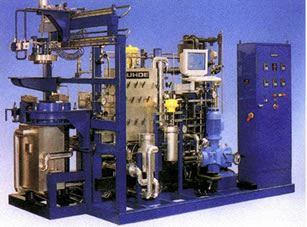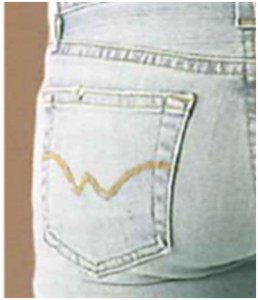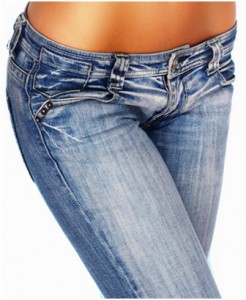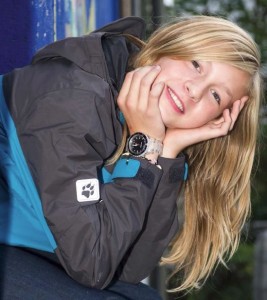Sustainable colouration concepts Part II. Waterless dyeing using supercritical carbon dioxide
 This article series is about latest trends and future perspectives in colouration technologies. The second part is about colouration using waterless dyeing concepts which is based on supercritical carbon dioxide, a technology invented in Germany 25 years ago.
This article series is about latest trends and future perspectives in colouration technologies. The second part is about colouration using waterless dyeing concepts which is based on supercritical carbon dioxide, a technology invented in Germany 25 years ago.
Water scarcity in many parts of the world is according to consensus view of the experts one of the potentially big crisis issues for the future (read water crisis). The textile industry being a major polluter and consumer of fresh water has to address this issue urgently and needs to develop more sustainable production concepts.
In part I. of this article series I have reported about new colouration concepts without any dyes or water consumption based on the “Morpho effect” which is purely a physical effect. However it will take time and requires more fundamental research until this technology would be established, and I would consider it as a fashion niche rather than a technology for bulk manufacturing.
In future, there will be demand for novel coloration technologies, waterless dyeing and recycling dyeing methods. In particular, waterless dyeing concepts such as dyeing of polyester fibres from supercritical carbon dioxide (sc-CO2) are of major interest.
Supercritical fluids such as sc-CO2 are already established in the extraction of natural ingredients for food, pharmaceuticals or cosmetics. Examples are aroma extraction, decaffeination, defatting, pesticide removal, phytoextraction, and sterilization (Evonik).
 DyeCoo, a company based in The Nederlands, started commercialising a machine for SC-CO2 dyeing, as the first machine on industrial scale for waterless dyeing of polyester. Supported by their partners Setex, Triade (dye distributor), FeyeCon (parent company) and Yeh Group (textile industry) the machine has been implemented at production scale at Tong Siang´s plant in Thailand. The fabrics are marketed under the brand DryDyeTM for their waterless dyeing technologies. Experience with bulk to bulk reproducibility and fastness levels is reportedly positive. As most remarkable achievement, DyeCoo could establish a strategic partnership with big brand Nike (read Nike-Dyecoo). According to Nike “the technology has the potential to revolutionize textile manufacturing” and “to have a particulary positive impact in Asia”.
DyeCoo, a company based in The Nederlands, started commercialising a machine for SC-CO2 dyeing, as the first machine on industrial scale for waterless dyeing of polyester. Supported by their partners Setex, Triade (dye distributor), FeyeCon (parent company) and Yeh Group (textile industry) the machine has been implemented at production scale at Tong Siang´s plant in Thailand. The fabrics are marketed under the brand DryDyeTM for their waterless dyeing technologies. Experience with bulk to bulk reproducibility and fastness levels is reportedly positive. As most remarkable achievement, DyeCoo could establish a strategic partnership with big brand Nike (read Nike-Dyecoo). According to Nike “the technology has the potential to revolutionize textile manufacturing” and “to have a particulary positive impact in Asia”.
Recently in the industry a wave of interest was initiated by the public Nike endorsement for the DyeCoo system. This may be because of increasing awareness among brands and textile industry for better environmental friendlier processes and because of technological progress in waterless dyeing technology.
 The technology as such is not new. Dyeing from supercritical carbon dioxide (sc-CO2) has been pioneered by German universities 25 years ago, especially in the group of Schollmeyer in Krefeld (see review article of Schollmeyer et.al ). Several significant patents have been filed since 1988 by the German inventors. Technology partners in textile machinery industry at the time were Jaspser who launched a prototype in 1991 and Uhde Hochdrucktechnik who piloted the technology in 1995 as a 30 L autoclave. Examples for implementation partners were Germany based textile companies Amann & Söhne on polyester thread years, Ado Gardinenwerke and TAG Garne Teppichverdelung, just to mention a few.
The technology as such is not new. Dyeing from supercritical carbon dioxide (sc-CO2) has been pioneered by German universities 25 years ago, especially in the group of Schollmeyer in Krefeld (see review article of Schollmeyer et.al ). Several significant patents have been filed since 1988 by the German inventors. Technology partners in textile machinery industry at the time were Jaspser who launched a prototype in 1991 and Uhde Hochdrucktechnik who piloted the technology in 1995 as a 30 L autoclave. Examples for implementation partners were Germany based textile companies Amann & Söhne on polyester thread years, Ado Gardinenwerke and TAG Garne Teppichverdelung, just to mention a few.
Yet the German technology never made it to industrial bulk scale, due to lack of public funding and immense technological and financial obstacles to be overcome during scale up of the technology. Now, 25 years after the invention and pioneer work, DyeCoo started entering the market.
Why did it take so long to commercialise a machine for bulk production ?
The share of water cost in European textile industry is only 6%, it seems at the time of development the pressure for change was not high enough and water was simply not of a major concern for the European based textile industry.
Then there were many technical challenges to be overcome. We want to elaborate further what is behind this technology.
 Above 74 bar and 31°C carbon dioxide will become a supercritical fluid . A supercritical fluid is any substance at a temperature and pressure above its critical point where distinct liquid and gas phases do not exist. Technically speaking, above the critical point, the carbon dioxide has properties of both a liquid and a gas, liquid-like densities and gas-like low viscosities and diffusion properties. This helps in dye dissolving as well as in shortening dyeing cycles.
Above 74 bar and 31°C carbon dioxide will become a supercritical fluid . A supercritical fluid is any substance at a temperature and pressure above its critical point where distinct liquid and gas phases do not exist. Technically speaking, above the critical point, the carbon dioxide has properties of both a liquid and a gas, liquid-like densities and gas-like low viscosities and diffusion properties. This helps in dye dissolving as well as in shortening dyeing cycles.
The dyeing of polyester with SC-CO2 is workable, although not without difficulties, and cost wise reserved for financially strong companies being able to finance the capital expenditure for the investment of the dyeing machine.
Dye selection and dye preparation or the disperse dyes, molecular structure and particle size in finishing, must be taken care of, due to solubility limitations in CO2. As a result, dyes selection are still somewhat limited and more research and development is required.
As by current knowledge, the dyeing of natural fibres with common conventional dyes is not workable for cotton, silk or wool, mainly because of solubility issues of the dyes in sc-CO2 and swelling issues – technically speaking hydrogen bonds in the natural fibres cannot be broken by sc-CO2. People have tried to overcome by pre-treatment using swelling agents. However this would apply additional processing steps (for pre-treatment and washing) talking away the advantages of water less dyeing. Another, in my opinion more promising attempt is the use of reactive disperse dyes (disperse dyes with built-in reactive groups, without water solubilising groups), a research area which is still ongoing. Substantial research of Reactive disperse dyes for sc-CO2 dyeing of cotton have already been made earlier and published in 2003 by Schollmeyer et al, and also in Japan. Originally such dye concepts came from R&D looking into one-bath one step dyeing of PES/CO blends.
Another issue is, supposing that new dye molecules would be required, in the initial phase it certainly remains to be seen who shall carry the investments for registration under REACh legislation – for a niche technology, as long as it stays a niche technology.
In polyester processing, advantages in waterless dyeing from SC-CO2 are full recycling, complete removal and recycling of CO2 after processing without need for drying, no discharge of effluent and no consumption of water. First of all it is a marketing tool for brands as well as for processing houses to be able to manufacture in a green process and hopefully getting better returns , in a very competitive global textile industry.
The technology has some disadvantages, too. The dyeing is carried out at 260-280 bar and 130 °C. Such high pressures require a special design of the textile machinery and up-scaling requires a very significant investment. Pressures of 260-280 bar are unusual conditions for the textile industry and may cause mental restrictions. Also, due to use of suffocating gas CO2, a control device for monitoring CO2 concentrations in air has to be installed for industrial labor safety reasons.
Parameter dependency is reported to be quite high , means there may be issues with lab-to-bulk and bulk-to-bulk repeatability, depending on the design of the machine and availability of a suitable lab scale equipment . Classical colour measurement will face some new challenges in this application, due to non additive behavior of the dye components. Other issues are oligomer migration and surface precipitation of dyes. All of these points have already been outlined in detail in the 2002 review article by German scientists ( Schollmeyer et.al ), and require diligent design of the machinery and dyeing process.
Yet Dyecoo, according to their claims, seem to have overcome many of these technical issues, made significant progress and launched their machine. Dyecoo´s website does not reveal too much of information. The disperse dyes for scf-CO2 dyeing of polyester are supposed to be modified disperse dyes. But anyway, they have brought the technology to the market, which is an honorable achievement which deserve to be acknowledged.
It is claimed that processing cost of sc-CO2 are lower than conventional dyeing, however, as mentioned above, the investment for the machinery is very high. Besides being green, there has to be a reasonable return on investment. How many people can take such an investment remains to be seen, in an industry where many people struggle for survival and spend a lot of time bargaining for cents savings on commodity dye prices.
Finally, some additional data, more down to earth, to bring things in perspective. Polyester is accounting for approximately 25% of textile processing, overall polyester is predominantly a commodity fibre with mostly commodity dyes being consumed. Even commodity disperse dyes have quite high exhaustion rates in conventional water based dyeing technologies. The bigger problems with coloured effluent and water consumption are in fact in the processing of cotton which is not (yet) workable as of now with sc-CO2, despite of intensive research on the matter since 25 years. Due to high capital expenditure in machinery sc-CO2 technology would be restricted for certain high quality branded articles such as high quality sportswear which are a fractional share of the polyester market. Another interesting figure is: The water usage for dyeing is 16% of total water consumption in the textile industry during processing. The share of water cost in European textile industry is reportedly 6%, in Asia more than 10% (higher relative share mainly because labour cost share is considerable lower). This means the new technology is surely a major step forward for the companies who can commercialise the same, yet there is a long way before the extraordinary claim of revolution in the textile industry can be met by waterless dyeing technologies. Technologically yes, commercially and impact-wise it remains to be seen. But somewhere you have got to start. Certainly the endorsement of a big brand my be the catalyst for a change.
To be continued.




This is indeed a need of hour technology.It will definitely have lot of impact on effluents which not only destroy ecological balance and have long lasting dmaging effect on aquatic life. God bless and wish this technolgy come into existence so soon as possible.
me gusto por que te da información de la escasees del agua que hoy en día, el agua es muy difícil de conseguir ya que no hay y tenemos que cuidarla aun mas.
announcing part III. of the article series. It will cover real serious issues and water saving colouration concepts.
where can I find part I ?
the link for part I. is under related post, “Colouration without Dyes”
Also, in category textile in the left sidebar you will find all related themes
direct link : http://blog.stepchange-innovations.com/2012/05/colouration-without-dyes/
Very interesting and informative!
Kindly refer to the above mentioned website for registering
and participating in the International conference on “Sustainability”. It will be a pleasure to meet at the forum.
the success of scCO2 will be continued:
http://www.adidas.com/com/goallin/news/2012/07/adidas-drydye/
excellent. thanks for the link.
Very innovative, did this technology has already been adopted in an industrial scale?
GREAT Step!!!!!
yes. According to my knowledge, as mentioned in the text the technology is already used in bulk production in Thailand for dyeing of polyester.
I would like to know more on this subject
Pingback: Clothing to dye for: the textile sector must confront water risks | All about V
Pingback: Project 1 | Marty Mac 515731